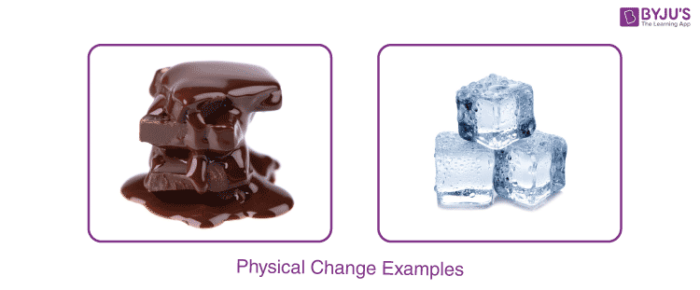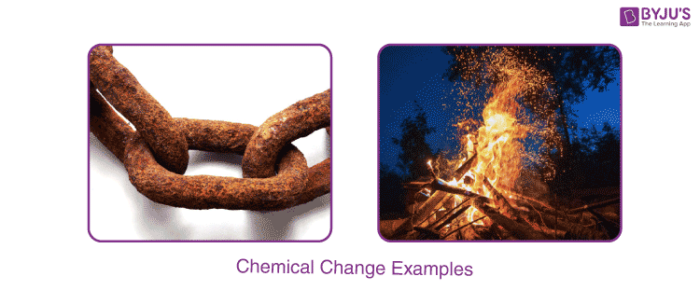What are Physical and Chemical Changes?
Everything around us undergoes certain changes. Changes can be either physical or chemical. The term ‘matter’ refers to anything that has mass and occupies space. It is made up of tiny particles and has physical and chemical properties.
- Physical properties of matter include its appearance and observable properties. Some physical properties are colour, odour, taste, solubility, rigidity, fluidity, melting and boiling points, etc.
- A chemical property is a property exhibited during a chemical reaction. This includes pH, reactivity, inflammability, etc. Let’s learn about Physical and Chemical Changes, and how they are related to physical and chemical properties.
Table of Contents
- Recommended Videos
- Physical Change
- Examples of Physical Change
- Chemical Change
- Examples of Chemical Change
- Difference between Physical and Chemical Changes
- Frequently Asked Questions – FAQs
Recommended Videos

Physical Change
When matter changes its observable properties, we can say it has undergone a physical change.
Physical change is a type of change where the physical properties of matter change. A change of state of matter, change in colour, odour, solubility, etc. all are examples of physical change.
During a physical change, neither the composition nor the chemical nature of matter is changed. During this change, molecules rearrange themselves without affecting the internal composition. A physical change doesn’t affect the chemical property.
Examples of Physical Change

Chemical Change
A chemical change is a type of change where the chemical properties of matter change. It is commonly called a chemical reaction.
Different substances have different chemical properties. According to this property, substances show variation in their reactivity. A chemical reaction results in a new product. During a chemical change, bonds between the molecules break and the composition of the substance change. In other words, chemical change leads to the breaking and making of bonds.
Examples of Chemical Change
Combustion, rusting, fermentation, etc. are a few examples of chemical change.

Difference between Physical and Chemical Changes
The following table shows major differences between physical and chemical changes.
| Physical Change | Chemical Change |
| Change in physical property | Change in physical and chemical property |
| Reversible process | Irreversible process |
| Energy is neither absorbed nor evolved | Energy is either absorbed or evolved |
| No new product formation | The new product is formed |
Frequently Asked Questions – FAQs
What is the physical change?
What are two examples of physical changes?
How is a chemical change different from a physical change?
Is the colour change a chemical reaction?
Is frying an egg a chemical change?
To learn more about physical and chemical change, download BYJU’S – The Learning App.

Name the law which from the basis of balancing a chemical equation.
A balanced chemical equation obeys the law of conservation of mass.
Read more here Law of Conservation of Mass.